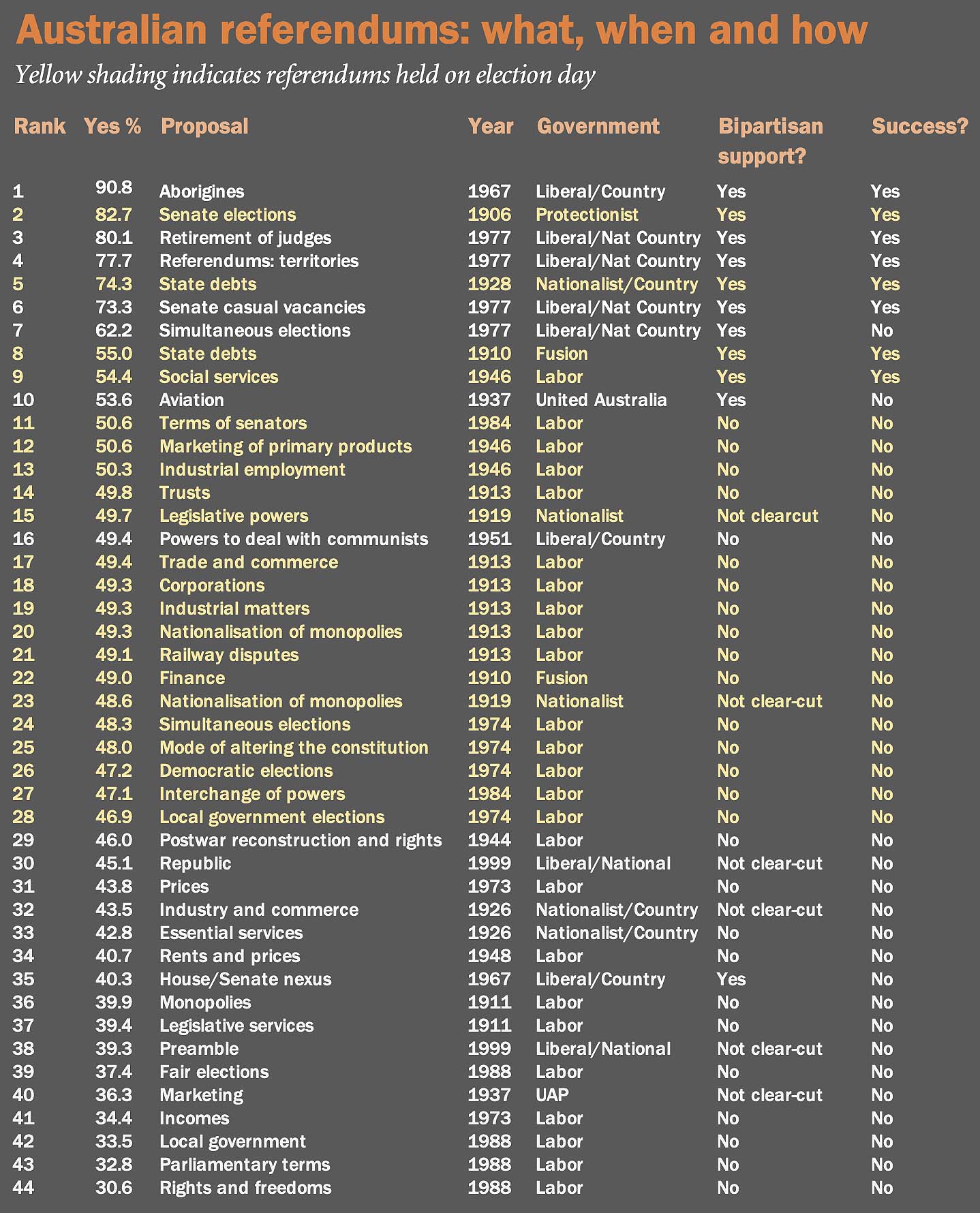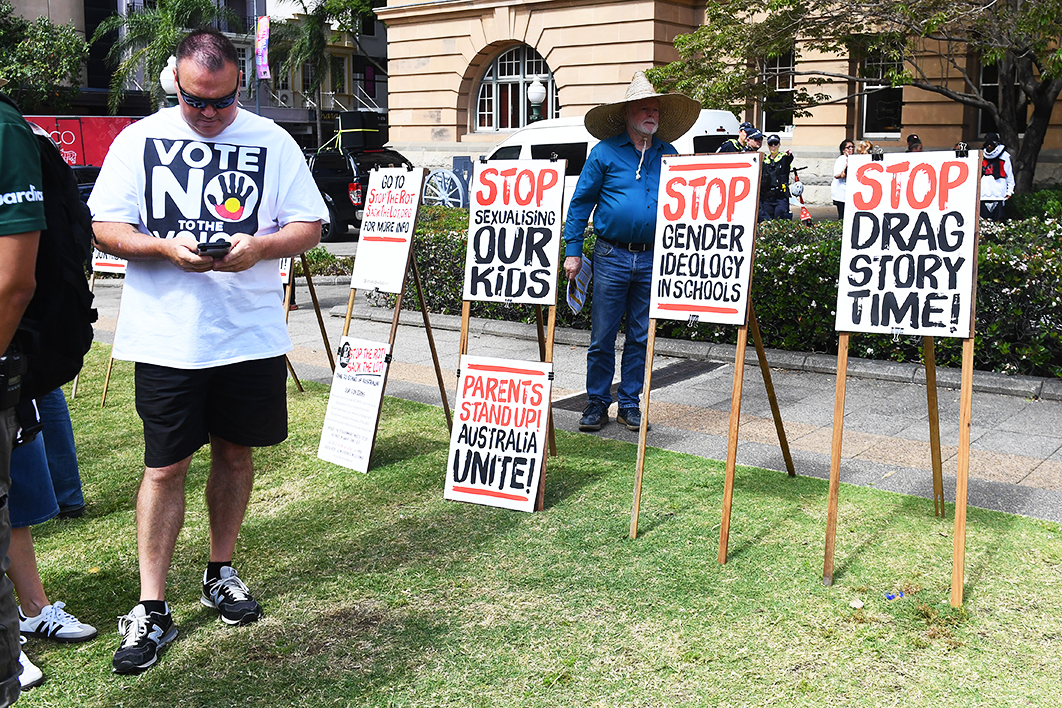The referendum campaign is a joke and an embarrassment, its messaging feeble and unfocused. It makes headlines for the wrong reasons, with clashing egos and serial wanderings off script, and it veers at times into the downright demented.
Never mind, it’ll win the vote hands down. That’s right, I refer to the official No case, which any visitor to this country with a mind unpolluted by survey results and media analysis would award very low marks indeed for its frequent drifts from covert to overt racism, its individual meltdowns, and its contradictions.
This, of course, is not how the political class sees it. They who adjudicate campaigns’ “performances” through the opinion polls — currently around 60 per cent for No — are in furious agreement that the Yes campaign has been atrocious.
This recent Nine article is a classic of the genre, with the inevitable Labor “senior figures with years of experience” proclaiming Yes “the worst [campaign] they have seen” while delivering glowing reviews to the No side, and particularly its — try not to laugh — “discipline.” (Meanwhile, in this week’s news, No leader Warren Mundine tweets of his desire to see one of the Yes identities bashed up.)
Now it’s true that the Yes side has made its share of mistakes and has its own inherent inconsistencies. We can all identify things that could have been done differently. But the No side wins the “undisciplined” crown hands down.
But the quality and professionalism of the campaigns isn’t the key issue, and it certainly isn’t responsible for the upcoming result. The scripts write themselves and the individuals are bit players, swept up by larger currents.
Why, in September 1988, some thirty-five years ago, did 62.4 per cent of Australian voters write “No” next to a constitutional referendum to “provide for fair and democratic parliamentary elections throughout Australia”? It surely wasn’t because they don’t believe elections should be fair and democratic. They would have had their purported reasons: it’s unnecessary, the government’s motives are suspect, the whole exercise is a waste of money.
And they would have had reasons for rejecting the other three questions posed at the same time, which all also got Yes support in the 30s.
The real reason was that it was a Labor referendum and it was being held midterm. That’s what always happens in these cases, and it’s happening now.
What did the huge 90.8 per cent Yes vote in 1967 tell us? It certainly wasn’t that racism was dead in Australia. That referendum’s most important consequence lay in activating the “race power” to enable the federal government to make special laws for First Nations people, but that detail was largely kept from the electors.
“Vote Yes for Aborigines” was the slogan, and the Yes campaign enjoyed the support of every member of federal parliament and every state government. Gough Whitlam’s Labor opposition campaigned energetically for it, as did Harold Holt’s government.
Today the 1967 result is steeped in mythology. The Uluru Statement was read out on its fiftieth anniversary. It was a motivator for next month’s vote.
And when the No case wins the only thing it tells us is that Labor governments shouldn’t hold midterm constitutional referendums. They go down, and badly, regardless of the topic.
Advocating for serious policy change in this country is never a fair contest. The proponents attempt to keep it simple and explain the modest benefits, trying to slide through journalists’ pesky questions without misspeaking into the evening news. They never promise nirvana, just modest improvement.
Opponents are not so constrained. Free to exaggerate and scream disaster, they fly a variety of kites, and if one crashes they simply send up another. All they have to do is sow doubt and confusion. They might cover themselves in mud in the process, but it doesn’t matter.
“If you don’t understand it, vote No.” It worked for Paul Keating against John Hewson and the GST in 1993 and it works today.
In reality, most change is never actually voted on. Instead, governments announce and implement changes (the Senate willing) within a term, and by the next election voters are largely used to them and the caravan moves on. When a party is unwise enough to take something substantial to an election, it influences some votes, sometimes enough to make a difference. Two stand-out cases are 1993 and 2019.
Constitutional referendums occupy a sub-category of their own. It’s not about who will form government. Australians, barely aware of the Constitution’s existence, are reminded that it is dangerous to tamper with the founding document of a country that, as we all know, is the “envy of the world.” The term “lawyers’ picnic” always gets trotted out.
We can all recite — let’s put it to music — that bipartisanship is a necessary but not sufficient condition for referendum success. The counterargument that bad proposals are unlikely to receive bipartisan support has some merit, but is let down by the fact that the non-Labor parties (the Liberals and Nationals and their earlier iterations) have sometimes opposed a change in opposition and then attempted to get the same thing passed in government.
The clearer pattern is that Labor government referendums are particularly prone to failure, and that’s largely because Liberal opposition leaders simply lack the authority to support them. Peter Dutton’s decision earlier this year was based solely on his desire to survive as leader; to grasp this we only have to try to imagine the opposite: Dutton ordering the party room to campaign for Yes. He’d probably be an ex-leader by now.
In the end, driven by the shocking Aston by-election result to seek comfort from the party base, Dutton opted for a particularly harsh No stance. Until then, total freedom for the rest of the party room — like the republic vote in 1999 — seemed an option.
Liberal prime ministers, on the other hand, usually possess the ability to ride roughshod over the party room — certainly that was true for Malcolm Fraser when he held referendums in 1977 and for Harold Holt ten years earlier. Both had massive election wins under their belts. Labor oppositions led (both times) by Gough Whitlam gave their full support, because Labor in its DNA believes in constitutional “reform” whereas the Coalition parties are innately suspicious of it. Out of the Coalition’s six proposed amendments in those two years, four passed, one received a majority of votes but not states, and one was badly beaten.
So if you want to know why the Liberals opposed a simultaneous elections referendum in 1974, proposed exactly that in government in 1977 and then ran against it again in 1984 (when it was more accurately referred to as “terms of senators”), that’s the reason.
And (I know I’m repeating myself) Labor mid-term referendums suffer a particularly harsh fate. This chart, colour-coded with mid-term elections in white and ones with concurrent elections in yellow, tells the story.

The dynamic holds true largely regardless of the actual proposed amendments. If a proposal is inherently ambitious (as the Voice could be characterised) it presents a juicy target; if it’s trivial, the apparent gratuitousness of the exercise becomes an issue. And there’s always some former judge or lawyer on hand, or at least someone with a law degree, to supply quotable words.
Recall also Tony Abbott in 2013, having agreed with the Gillard government to support recognition of local government, jumping ship at the last minute after a party-room revolt.
So any purported analysis that assumes agency on Dutton’s part — that he thought it would be good politics or was acting with sincerity — is just theatre. He did what he thought maximised his chances of being Liberal leader at the next election; his personal inclinations, whatever they were, barely mattered.
Like this year, 1988’s set of four questions started with very high support that whittled down (and eventually halved) by voting day. Yet two referendums run just four years earlier, with the 1984 election, did much better. Barely remembered today, and little thought about at the time because they were swamped by the election proper, they received Yes votes of 50.6 and 47.1 per cent.
A loss is a loss is a loss, but some losses come closer to succeeding than others. Labor government referendums held with elections have historically received much higher support, four of them managing national majorities and one actually passing (in 1946). The average Labor government midterm referendum Yes vote is 37.9 per cent; with elections it’s 49.3.
(Incidentally, with tiny Tasmania set to break with referendum tradition and deliver a higher Yes vote than the national average, the likely space for a sixth “double majority” loss shrinks substantially. Electoral maestro Kevin Bonham uses survey data to put it at 50 to 51 per cent. That is, anything more than 51 per cent nationally would probably pass. This is of less relevance to the 14 October vote, which will struggle to even get into the 40s, than to the road not travelled of a referendum held with the next election.)
The Voice proposal came not from the Albanese government but from the Uluru Dialogues. But it was the government’s decision to hold the vote midterm. It presumably believed bipartisanship would be difficult to achieve with a general election — that a midterm vote would facilitate an uncluttered national conversation — and it was encouraged by the early surveys into believing that this time bipartisanship mattered less.
Tick, tick and tick, all just like 1988. Labor, the party that obsesses over its own history, seems determined not to learn this particular lesson. •





